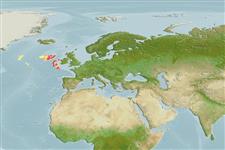Holocéphales (chimères) (chimaeras) >
Chimaeriformes (Chimaeras) >
Chimaeridae (Shortnose chimaeras or ratfishes)
Etymology: Chimaera: Named for the mythological creature composed of parts of multiple animals, referring to their odd mix of characteristics. (See ETYFish); opalescens: Latin for opalescent, referring to characteristic iridescent coloration of fresh specimens, resembling nacreous colors of the semi-precious stone opal. (See ETYFish).
Environment: milieu / climate zone / depth range / distribution range
Écologie
marin bathydémersal; profondeur 900 - 1408 m (Ref. 87424). Temperate; 57°N - 48°N, 6°W - 11°W
Northeast Atlantic, along the slope to the west of the British Isles and France (Ref. 87424).
Taille / Poids / Âge
Maturity: Lm ? range ? - ? cm
Max length : 96.8 cm TL mâle / non sexé; (Ref. 87424); 109.8 cm TL (female)
Description synthétique
Clés d'identification | Morphologie | Morphométrie
Chimaera opalescens can be distinguished from its congeners by the following combination of characters: body evenly coloured, iridescent, varying from beige to tan in adults and bronzish in juveniles; unpaired fins brown to purple, uniformly coloured or with pale or whitish edges; iris black; claspers tripartite divided for one third of their length, not extending beyond the pelvic fins in adults; dorsal spine equal or shorter than first dorsal fin; ventral caudal lobe equal or deeper than the dorsal caudal lobe. Comparison of DNA sequences of the CO1 gene with those of related species supported C. opalescens as a distinct species (Ref. 87424).
Life cycle and mating behavior
Maturities | Reproduction | Spawnings | Egg(s) | Fecundities | Larves
Luchetti, E.A., S.P. Iglésias and D.Y. Sellos, 2011. Chimaera opalescens n. sp., a new chimaeroid (Chondrichthyes: Holocephali) from the north-eastern Atlantic Ocean. J. Fish Biol. 79(2):399-417. (Ref. 87424)
Statut dans la liste rouge de l'IUCN (Ref. 130435)
Menace pour l'homme
Harmless
Utilisations par l'homme
Outils
Articles particuliers
Télécharger en XML
Sources Internet
Estimates based on models
Preferred temperature (Ref.
123201): 7 - 9, mean 8.3 °C (based on 6 cells).
Phylogenetic diversity index (Ref.
82804): PD
50 = 0.5000 [Uniqueness, from 0.5 = low to 2.0 = high].
Bayesian length-weight: a=0.00282 (0.00118 - 0.00673), b=3.10 (2.89 - 3.31), in cm total length, based on LWR estimates for this (Sub)family-body shape (Ref.
93245).
Niveau trophique (Ref.
69278): 3.7 ±0.6 se; based on size and trophs of closest relatives
Résilience (Ref.
120179): Très faible, temps minimum de doublement de population supérieur à 14 ans (Preliminary K or Fecundity.).
Fishing Vulnerability (Ref.
59153): High to very high vulnerability (66 of 100).
Nutrients (Ref.
124155): Calcium = 12.5 [3.9, 36.9] mg/100g; Iron = 0.281 [0.104, 1.093] mg/100g; Protein = 15.3 [10.4, 19.0] %; Omega3 = 0.495 [0.216, 1.141] g/100g; Selenium = 21.7 [5.9, 59.4] μg/100g; VitaminA = 9.21 [2.75, 29.32] μg/100g; Zinc = 0.429 [0.217, 0.804] mg/100g (wet weight);
